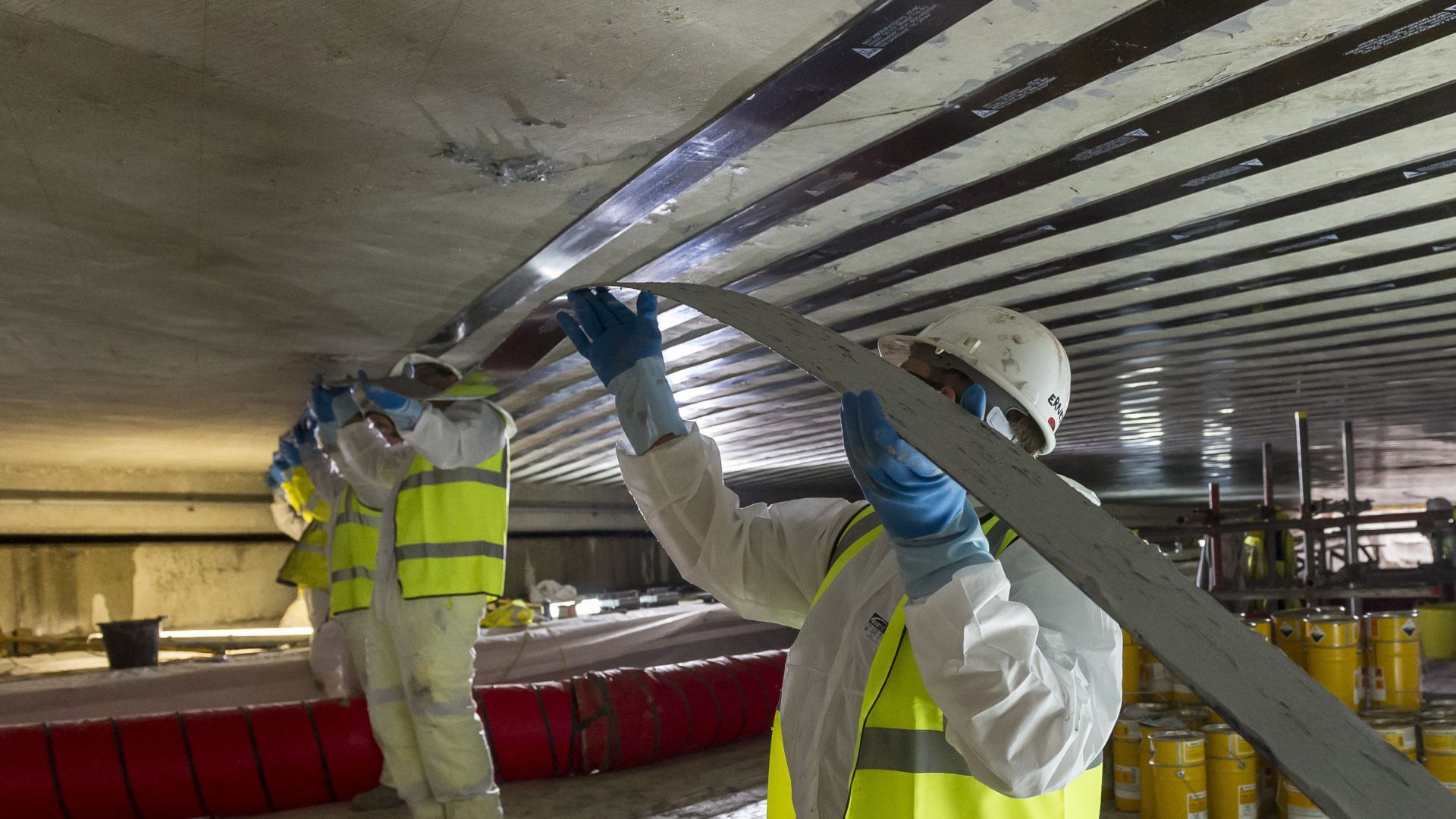Prestressing Systems for Structural Strengthening with Sika® CarboDur® CFRP Plates
The Concept of Prestressing
Prestressing – Applying forces to a structure to deform it in such a way that it will withstand its working loads more effectively or with less total deflection. (Post-tensioning is a method of prestressing a poured in place concrete structure after the concrete has hardened).
Principles of Sika® CarboDur® Prestressing Systems
A prestressed Sika® CarboDur® CFRP plate combines the advantages of bonded Sika® CarboDur® CFRP plate strengthening with those of conventional prestressing. The Sika® CarboDur® CFRP plate applies compressive stress in the tensile zone of the cross-section, thus reducing tensile stress in steel reinforcements under service load, and consequently crack width and deflection will be reduced. For calculation of the load-bearing capacity, the tensile force in the prestressed Sika® CarboDur® CFRP plate is added to the tensile strength of the steel.
- Longitudinal and transverse strengthening of bridges
- Seismic strengthening of masonry and concrete walls
- Strengthening of industrial and commercial buildings
- Strengthening in all climatic conditionsIncreased durability
Advantages of Prestressed Sika® CarboDur® CFRP Plates
As compared to Prestressing Steel
- Easy prestressing of existing structures
- Lower weight for easy handling
- Lower loss of prestress due to higher initial tensile strain
- Compact because of thinner section
- Comparable stress level to much heavier prestressing steel
- No stress corrosion risk
- Corrosion resistant tendons
- Bonded or non-bonded possibilities
As compared to Sika® CarboDur® CFRP Plates applied without Pre-tensioning
- Optimal use of the high tensile strengths of the Sika® CarboDur® CFRP plates
- 30% to 50% less plates needed
- Optimal cost /performance ratioIncreased durability with reduction of crack width and tensile steel strainNo corrosion risk
- Strengthening effect can also be “appropriate” for dead and permanent load
- Reduction of tensile strain of existing steel reinforcement
- Strengthening of coupling joints of prestressed reinforced concrete bridges
- Possibility of structural strengthening at low substrate temperatures and high humidity without expensive additional precautions (enclosure, heat etc.)
- Low plate thickness up to only 2.4 mm
- Only short end-anchors required
Strengthening of structures with post-tensioned CFRP plates
StressHead® CarboStress® is a system for strengthening by the post-tensioning of carbon fiber reinforced plastic (CFRP) plates. The posttensioned plate is anchored with a compact StressHead that remains permanently on the structure. Movable and fixed anchors are used to transfer the tensioning force into the structure, and these can be combined and positioned according to the needs of the project.
StressHead®-CarboStress® post-tensioning system components
StressHead® 220
- Material CFRP
- Tensioning force FP0 = 220 kN
- Anchored force FSpk,min = 300 kN
The CarboStress System
- High-strength CFRP plate
- Post-tension σP0 = 1’410 N/mm2
- Post-strain εP0 = 8.5 ‰
- Tensile strength ftk ≥ 2’800 N/mm2
- Longitudinal modulus ≥ 165‘000 N/mm2
- Protective plastic duct optional
Bridge Structures
The load-bearing capacity or functionality of bridges can deteriorate due to higher than anticipated live loads, changes to the structural system, corrosion, or defects in their design and construction. Insufficient longitudinal or transverse bearing capacity of the concrete deck can often lead to cracks. CFRP plates posttensioned with the StressHead® CarboStress® system can reduce crack widths due to the active tensioning force that is applied.
Advantages
- Low space requirement on the bridge deck
- Can be used both transversely and longitudinally
- Secure end anchorage
- Large movement range – low tension losses
- No corrosion
- Shear strengthening
- Reduction in crack widths and damage
- Strengthening for additional demands
- Transverse and longitudinal bending strength enhancement
- Structural support and pier strengthening
Industrial and high-rise buildings (incl. earthquake strengthening)
Slabs and beams often must be strengthened to allow for higher live loads and changes of use for example. The concentrated transfer of force at the end of the CFRP plates results in clearly configured structural conditions. When the strengthening requirements cannot be achieved with bonded CFRP plates without tension, the StressHead® CarboStress® system is the best solution. Masonry walls often have insufficient loadbearing capacity to absorb the horizontal forces generated by earthquakes. Vertical posttensioning with CFRP plates utilizes the shear strength of the masonry to its fullest capacity.
Advantages
- Vertical post-tensioning utilizes the shear strength of the masonry to the full
- Lightweight units, no lifting gear
- Improved durability
- Can also be used to strengthen historic buildings
- Ceiling / soffit strengthening
- Earthquake resistance strengthening
- Strengthening due to change of use

